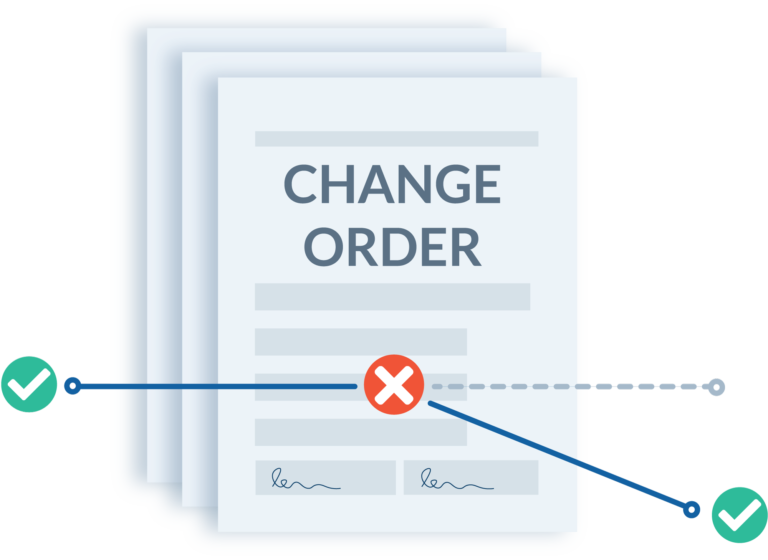What is a change order?
- Change Order Resources
Download a free change order template
Choose from a variety of customizable templates in Excel, Word, and PDF format. Choose the right change order form based on the type of contract you're using (fixed sum, T&M).

AIA G701 Change Order Guide
Read our guide to the AIA G701 Change Order, with a step-by-step walkthrough explaining how to fill it out.
Change Order FAQs
Have questions about how change orders work, or how to use them on a construction project? View the answers to frequently asked questions (FAQs) about change orders, and how they affect your ability to get paid.
A change order is an agreement between two parties on a construction project to change or amend the scope of work in the original construction agreement or subcontract.
Construction projects are complicated, and plans can change often from the original design. However, when a change arises, it is critical to get as much detail about the change in writing. While a change may be initiated by either party, both must agree on the amendments to the work and cost associated with the change.
Top Down, Bottom Up Change Orders
Changes can come from the top down, such as when an owner or architect makes design changes after the project begins. Changes also come from the bottom up. If a contractor encounters differing site conditions or another obstacle that affects their ability to complete the scope of work, they may submit a request for change order to the GC or property owner.
Change Order Management Tips
Change orders create a record of any additional services requested by the customer, along with the relevant cost increases. It’s always best practice to get everything in writing, and in some jurisdictions, it may be legally required.
Here are some management tips to streamline the change order procedure:
- Plan ahead
- Use Change Order Templates
- Collect Daily Reports, Photos, & other Detailed Information
- Get Written Approvals
- Communication
Best practices
Unapproved Change Orders
Poor change order management is a problem that can impact your entire business. Change orders can lead to many “hidden” losses for contractors. Because of this, contractors should also seek a written approval for their change orders. Experienced contractors and subs should avoid starting any jobs or work on any project until a change order is approved in writing. Aside from physically working on jobs, contractors should also hold off scheduling the work or ordering materials.
- Read more:
Change in the Scope of Work
A construction contract contains information about the scope of work that both parties agree upon. The scope of work is a detailed description of the work expected from contractors and subs. It spells out exactly what the contractor or sub is required to do under the contract. The scope of work might be a section in the contract, or a separate document attached to the agreement.
The scope of work will outline who is responsible for completing each task, the project schedule, and any other necessary details for contractors and subs to understand their role and responsibility on the job. It establishes each party’s rights and obligations.
Plans change often on a construction project. When changes come up that are outside of the original scope of work, a change order is generally required.
Scope Creep
It’s not uncommon for the hiring party to ask a contractor to perform additional work on the fly, without providing a change order. Often, these changes may seem inconsequential – they don’t take a lot of time, or significantly affect the project cost – so contractors and subs make the change without documenting it. A few small changes may not break the bank, but they can add up quickly; this is known as scope creep. If you’re not documenting change orders, you may not realize how much these small changes are costing you until you’ve completed the project.
Change Order Format
A change order typically includes:
- A description of the requested change
- An overview of the costs associated with the change in work
- Supporting documents
- Any impact on the construction schedule
Free change order templates
Payment Applications
When you submit a payment application, you should include all change orders approved during that period. An application for payment should contain documentation supporting all work that you’re requesting payment for – including change orders.
- Payment Application Checklist: Include these documents
- How change orders affect your application for payment
How Change Orders Work
Order or Directive?
A change order is a signed agreement between two parties. A change directive, on the other hand, is effectively a command. When the contractor and owner can’t agree on changes, an owner may be able to override their contractor with a change directive.
Deductive Change Orders
A change order doesn’t always increase the work and contract price. It can also decrease it through a deductive change order.
When changes don’t affect cost or time
The architect’s supplemental instruction may also be used to make changes to a contractor’s work, but only when the contract cost or schedule are not affected by the change.

